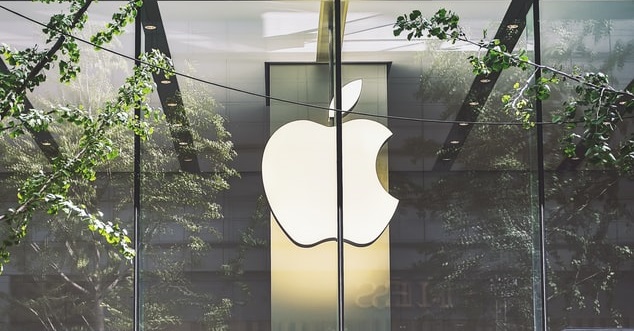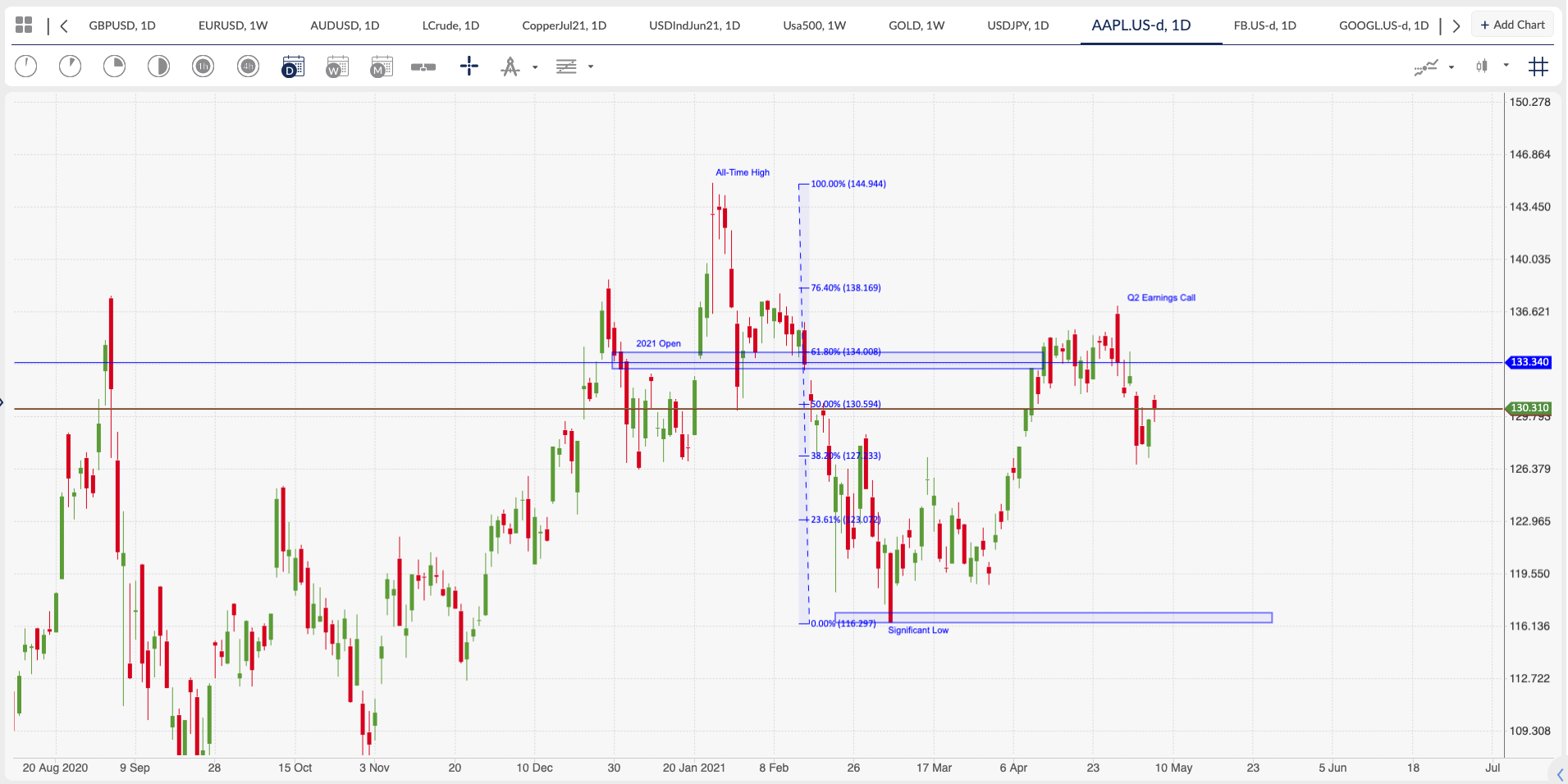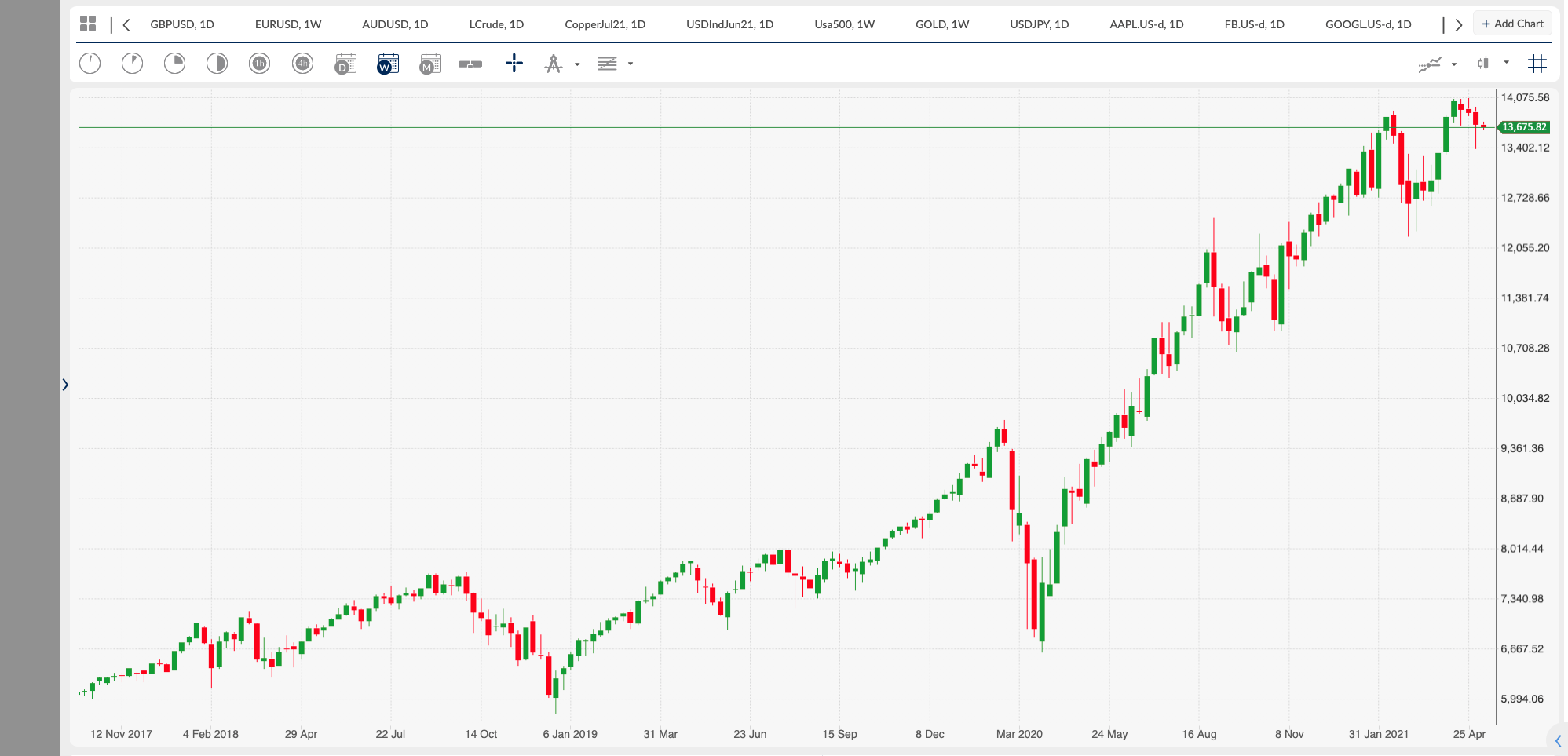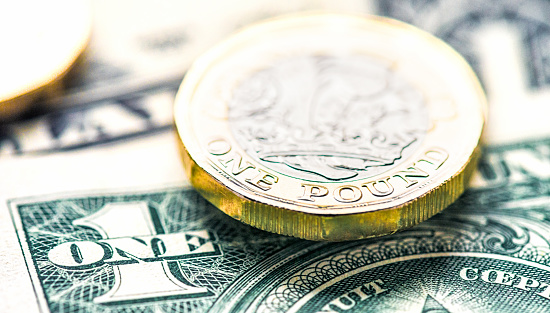Weekly Investment Analysis
Apple (APPL) delivered on earnings for Q2 2021, with Overall revenue and Services revenue rising considerably, beating market expectations. The share price after the initial earnings call spike has dropped from 137.040 to 126.700 and is unable to maintain prices above the 2021 opening of 129.020, so was it a blow-off top or is there higher prices to come?
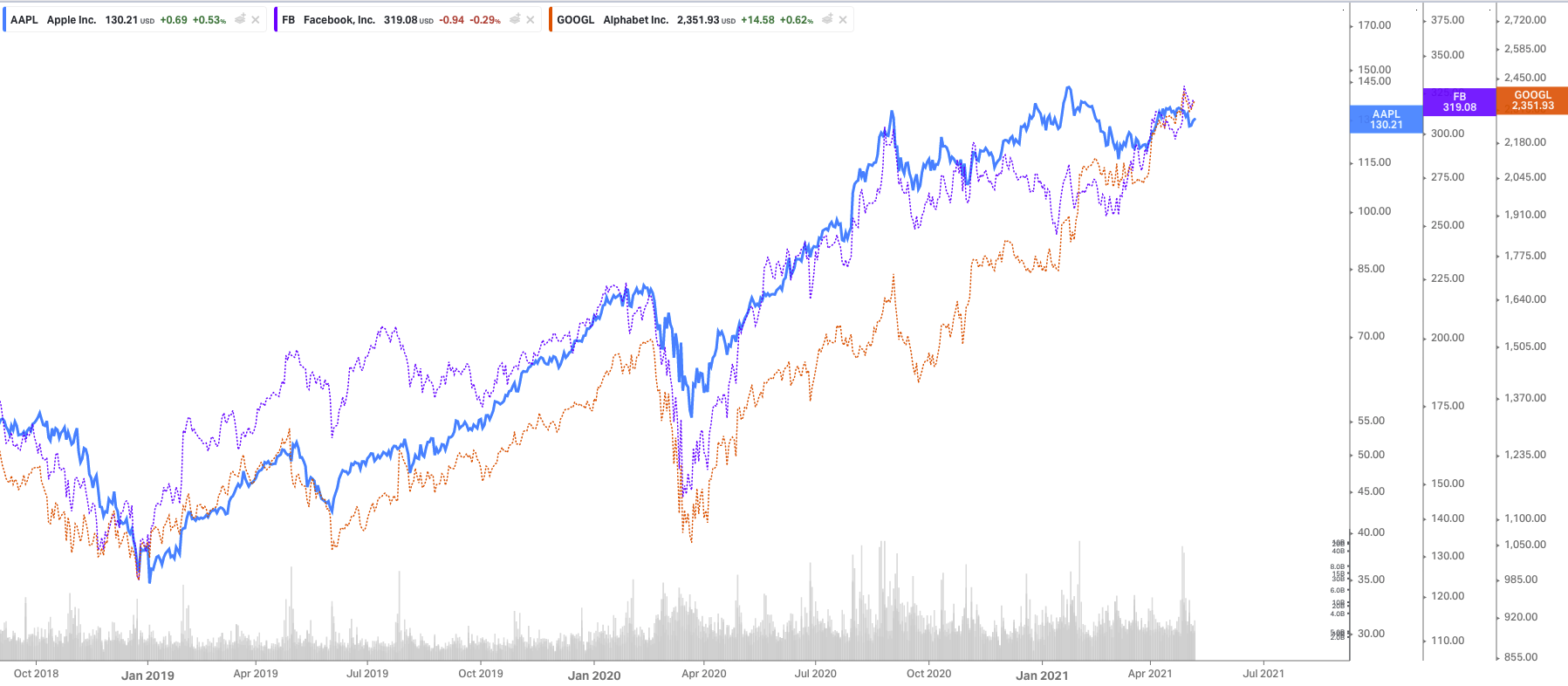

Looking at a chart of the 3 big tech heavyweights, APPL is not currently following the price action of Google (GOOGL) and Facebook (FB). GOOGL & FB are both making higher highs and higher swing lows, whereas the APPL price action has a way to go before we see a new significant swing high above the all-time highs of 145.050.
APPL revenues grew 53.7% to $89.6 billion, thumping estimates by $12.3 billion. Net income grew 111%, their earnings per share (EPS) raised 119% to $1.40, beating expectations of $0.99 per share. Both Google and Facebook beat their earnings expectations too, which the Nasdaq 100 had been signalling with its recent all-time highs in early April.
January 2019 and March 2020 were the most recent significant lows for APPL before the stock split in August 2020. Since then, the market has been pushing and pulling the share price between a fairly tight $40 range. 124.00 is the middle of this new trading range and so a significant line in the sand for value buyers as seen in early March 2020 when the move down to 116.00 was bought up in anticipation of the earnings. “Buy the rumour, Sell the news” was definitely on some traders’ minds, but maybe the value is still there to be taken for those that are long term greedy.
The Pandemic Effect
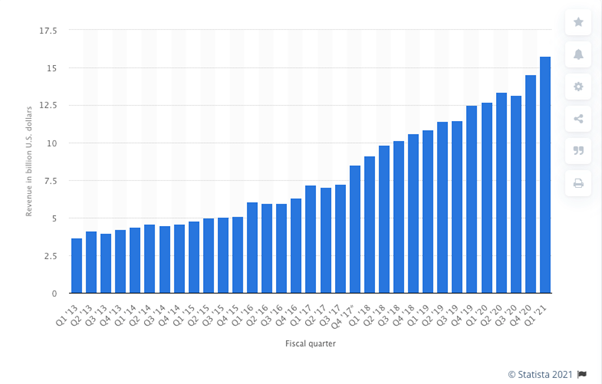

There has been a significant shift in the behaviour of everyone, as we had to work from home (WFO), and this has been great for tech stocks. During the early stages of WFO getting your hands on a laptop, screen or webcam became impossible due to demand outstripping supply. Apple Mac sales grew 42% to $17.8 billion, and with more children staying at home too, this trend may have had something to do with the increase in iPad sales to $16.2 billion. Services revenues, which include iTunes and the App Store grew 27% to $16.9 billion.
The next quarter revenue is also set to increase as stated by the management team on the Q2 investors call saying, they “expect June quarter revenue to grow strong double digits year-over-year.” Though it should be noted that the stay-at-home stocks have all done very well at attracting customers who were forced into a situation where they had to both work and entertain themselves/families within the confines of their homes.
By this I mean, a lot of people who were maybe thinking about purchasing an Apple product would have had their purchase timeline brought forward, rather than waiting another year for their current Apple product to become more obsolete. Or if they found themselves lacking the required kit to both work effectively from home or keep everyone entertained during the restrictions. Yes, the Apple fanboys will always purchase the latest and greatest products, but the general public would baulk at paying over the odds for equipment on a regular basis, and now they have their iPad and iMac, they will not be in the market for more Hardware anytime soon. This does not mean services will not make year on year gains, but the general revenues may not be so parabolic.
The Buy Back
Apple has for the past 3 years been aggressively reducing its free cash flow. Having amassed more money than some sovereign nations the goal has been to get to a “cash neutral situation”. Which is a phrase used on February 1, 2018, by Luca Maestri, the company’s CFO, when he stated that due to changes in the tax laws, “Tax reform will allow us to pursue a more optimal capital structure for our company. Our current net cash position is $163 billion. And given the increased financial and operational flexibility from the access to our foreign cash, we are targeting to become approximately net cash neutral over time.”
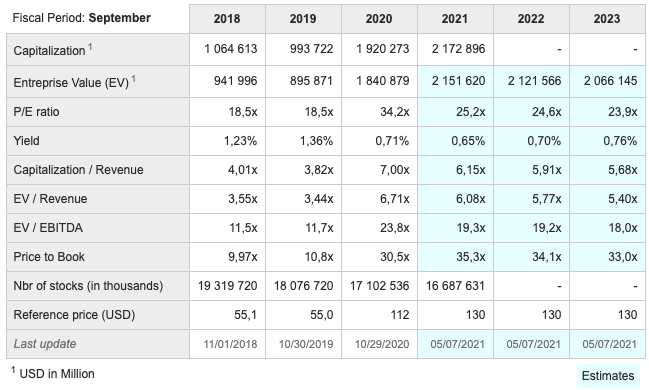

The latest figures for Apple’s Net Cash Position were $21.2 billion, showing potentially how much of a stock buyback they have engaged in these last few years. Stock buybacks elevate the stock’s price which benefits the stockholders, this should give some warning to the speculators out there after the drop in the net cash position by around $140 billion, should the company shift away from this activity.
Ai Investment
Mark Cuban recently stated on a podcast that he separates companies he wishes to invest in between those that have Artificial Intelligence (Ai) and those that do not. Because the companies that have spent the money on the Ai are ahead of the game and are always outperforming those that do not. Those that do not have Ai will have to spend a lot of money because Ai is really hard and really expensive to get right.
In 2016 Apple acquired artificial intelligence start-up Turi Inc. for about $200 million, in a bid to amass innovative computing capabilities for its products and services. But since Steve Jobs regained the helm in 1997 (and also through his successor Tim Cook), Apple has been obsessively seeking to perfect the user experience. Siri is their most obvious interface to the Ai. The acquisition of Turi helped developers create and manage software and services that use machine learning (ML). From this capability, they were able to design recommendation engines, detect fraud, analyse customer usage patterns and better target potential users, as seen in their facial recognition for Home kit, the native sleep tracking within the Apple Watch, App library suggestions, translate app, and sound recognition.
In 2020 Apple spent $18.8 billion on research & development (‘R&D’) which equates to 6.8% of revenues, Alphabet (GOOGL) spent 15.6% of revenues and Facebook (FB) spent 21.4% of revenues. Which could suggest that Apple is currently falling behind the curve on development, or for the glass half full investors, maybe they are more efficient at it. Going by the Cuban filter, I would suggest the measly 6.8% is not enough of their budget to keep ahead of the game.
The future
See real-time quotes provided by our partner.
See real-time quotes provided by our partner.
The estimates are for the next couple of years growth in EPS to decline and for there to be a change in the business model, as clearly, they cannot keep chasing valuations higher with stock buybacks. There was a time when IBM put investors returns before product and innovation and that was a time when Apple took advantage of their incumbent market share. Google and Facebook don’t necessarily compete in the same areas as Apple’s traditional business but the ‘Internet of Things’, Ai, Autonomous Vehicles, Big Data etc. are all part of what Apple could do better at and they still have to fight off the Android and Chromebook market.
With the more adversarial developments between themselves and Facebook, Apple seems to be trying to pull the rug from underneath the social media company and their $85.9 billion from targeted online advertising. If Apple successfully kills off that revenue stream or at even dents it, Apple can concentrate on the hardware and user experience markets and maintain being the biggest player.
See real-time quotes provided by our partner.
With Apple currently trading in the middle of the 2021 range, any break lower with a close lower than 126.50 would be bearish for the medium-term price, in my opinion. Failure to hold above the 133.50 level signals enduring weakness and the logical target to the downside would be the years low and then possibly, the gap from July/August 2020.
See real-time quotes provided by our partner.
The Nasdaq is finding it hard to maintain bullish momentum as inflation fears grow, so we could be seeing a larger tech sell-off/correction after the earnings season.
There is also the possible seasonality effect of ‘Sell in May and go away’, until the next product launch which is traditionally around September time.
For the uber bulls and long-time investors, anytime we get above the 2021 opening price and start taking out the all-time highs will be a sign to start looking again for buy the dip opportunities and trend continuation strategies.
